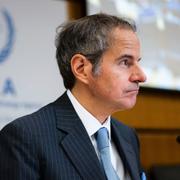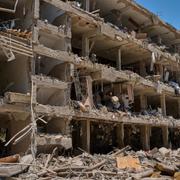
Israel varnar: Hizbollah utplånas om de lägger sig i
Israels försvarsminister Israel Katz varnar Hizbollah för att lägga sig i landets konflikt med Iran. Det rapporterar Reuters.
Hizbollahledaren Naim Qassem öppnade på torsdagen för ett svar på det han kallade ”brutal israelisk-amerikansk aggression” mot Hizbollahs långvariga allierade.
Israel invaderade Hizbollah-kontrollerade Libanon i oktober 2024, efter ett kortare markkrig slöts en vapenvila och Israel drog tillbaka sina trupper. Man har dock fortsatt angripa mål inne i landet.
Enligt Israel Katz är Israel redo att kraftigt trappa upp konflikten:
– Om det blir terror kommer det inte finnas något Hizbollah kvar, säger han.
bakgrund
Konflikten mellan Israel och Hizbollah
Wikipedia (en)
An ongoing conflict between the Lebanese militant group Hezbollah and Israel began on 8 October 2023, when Hezbollah launched rockets and artillery at Israeli positions following Hamas' October 7 attacks on Israel. The conflict escalated into a prolonged exchange of bombardments, leading to extensive displacement in Israel and Lebanon. The conflict is part of the broader Middle Eastern crisis that began with Hamas' attack, with the short Israeli invasion of Lebanon in 2024 marking the largest escalation of the Hezbollah–Israel conflict since the 2006 Lebanon War.
On 8 October 2023, Hezbollah started firing guided rockets and artillery shells at Israeli positions in the Shebaa Farms, which it said was in solidarity with Palestinians following the 7 October Hamas-led attack on Israel and beginning of Israeli bombing of the Gaza Strip. Israel retaliated by launching drone strikes and artillery shells at Hezbollah positions. Israel also carried out airstrikes throughout Lebanon and in Syria. In northern Israel, the ongoing conflict has forced approximately 96,000 individuals to leave their homes, while in Lebanon, over 1.4 million individuals had been displaced by late October. Hezbollah stated it would not stop attacks against Israel until it stops its military operations in Gaza; Israel said its attacks would continue until its citizens could return safely to the north.
In September 2024, Israel intensified its operations with two waves of electronic device attacks targeting Hezbollah's communication systems, and later assassinated the group's leading figures, including Secretary-General Hassan Nasrallah, and his successor, Hashem Safieddine.
On 1 October, the Israeli military began an invasion of southern Lebanon, although it had been conducting limited ground operations for some time. Israeli operations led to the significant dismantling of Hezbollah's military infrastructure in southern Lebanon and the destruction of a large portion of its missile stockpile.
A 60-day ceasefire agreement was brokered and took effect on 27 November 2024. The ceasefire required Hezbollah to move its fighters north of the Litani River, approximately 30 kilometres (19 miles) from the Israeli border, while Israel began withdrawing its forces from southern Lebanon. The Lebanese Army was tasked with deploying around 5,000 soldiers to monitor the situation and maintain peace in the region. The ceasefire is being monitored by a panel of five countries, led by the United States, though Israel retains the right to strike at immediate threats in Lebanon during this period. The ceasefire was extended to 18 February 2025, at which time the Israel Defense Forces (IDF) withdrew from most of southern Lebanon.
Omni är politiskt obundna och oberoende. Vi strävar efter att ge fler perspektiv på nyheterna. Har du frågor eller synpunkter kring vår rapportering? Kontakta redaktionen



